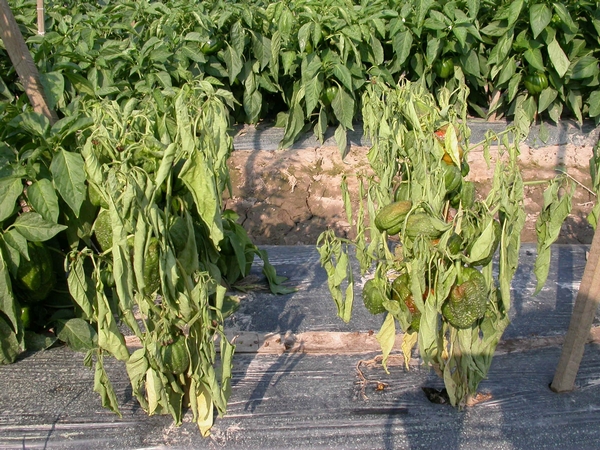Jun 24, 2019Wet, humid weather challenges vegetable disease management
Moisture drives diseases more than temperature, especially this time of the growing season. The frequent rains and days with high humidity keep leaves wet for an extended period of time. The longer leaves are wet from rain, dew or fog, the more likely that pathogen spores (who may have found their way to their preferred host) will be able to germinate, penetrate the leaf and cause disease. Below, I’ve summarized the likely outbreaks that I’ve been thinking about.
Asparagus
Rain prompts the release of purple spot (Stemphylium vesicarium) spores from their overwintering sites in the fern residue. Growers have reported purple spot on harvested spears so it’s clear that our current weather pattern is causing an uptick in this disease. While there is not anything that can be done to protect the harvested spears, growers should be protecting their younger plantings that are no longer being harvested and have begun to fern out.
Applications of a fungicide containing chlorothanil are recommended to begin for plantings that are no longer being harvested and could be considered to begin even before the fern is completely developed. Intervals between applications may need to be shorter than normal for this time of year. As long as these wet/humid conditions continue, fungicide applications to the fern every 7 to 10 days should be considered.
Cucumbers
Cloudy, humid and wet weather are perfect conditions for downy mildew. These conditions also favor the transport of downy mildew sporangia into our Michigan growing areas. My lab has been monitoring for the downy mildew sporangia for over a month. The sites of the spore traps and the spore counts to date can be found at the top of Dr. Hausbeck’s Downy Mildew News webpage listed under “Cucurbit Downy Mildew.”
This year, we are able to distinguish between the sporangia from cucumber downy mildew and hop downy mildew. All of the sporangia that we’ve detected so far are the hop downy mildew which don’t pose a threat to cucumbers. In past years, the first downy mildew field symptom has been found in the state in early July. All outbreaks of downy mildew in the state will be reported on the Downy Mildew News webpage. Current recommendations can also be found on this webpage in the Fact Sheet, “Monitoring and Managing Cucurbit Downy Mildew.”
Peppers
Phytophthora crown and root rot will surely be a problem this season as this disease is caused by a water mold than enjoys saturated soils. There is a fact sheet available on this webpage that offers specific information on how to manage this destructive disease. It’s important to emphasize that fungicides applied to the foliage and the lower pepper stem are not effective. Research conducted in my lab over several years has clearly shown that fungicides are effective in protecting peppers when applied via drip as a soil treatment. Soil-applied fungicides and resistant cultivars are the only effective means of limiting crown and root rot on peppers.
Onions
This crop has had Stemphylium leaf blight as an important foliar disease in recent years. Previously considered to be a secondary pathogen, it appears that Stemphylium is able to be a primary pathogen that must be controlled early in the season. Based on our fungicide field plots from last year, once the leaf blighting begins from Stemphylium, it seems nearly impossible to keep the foliage protected. Our research also showed that the fungicide Quadris and other strobilurin fungicides did not limit Stemphylium and are not recommended. For our field study, Luna Experience SC provided acceptable disease protection and produced the highest total yield.
It’s important to consider using this fungicide early in the season, especially under wet conditions. Another important note from this field study is that mancozeb did not perform as well as well as chlorothalonil in protecting the onion foliage from Stemphylium. However, to protect onion foliage, a broad-spectrum protectant such as chlorothalonil will not be adequate and other, locally systemic fungicides, will be needed.
– Mary Hausbeck, Michigan State University Department of Plant, Soil and Microbial Sciences
Wilting of pepper plants infected with Phytophthora crown and root rot. Photo: Mary Hausbeck















